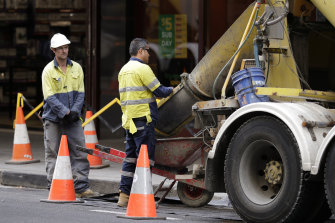Key posts
The Victorian government has committed to a $3.8 billion overhaul of the state’s struggling mental health system after the state’s royal commission found it had “catastrophically failed to live up to expectations”.
A new tax on businesses with more than $10 million in wages nationally will raise almost $1 billion a year to bankroll the changes to mental health to rebuild the failing system.
The focus of the mental health spending package is $1.5 billion on community-based care to minimise the need for people to travel far to access mental health services.
The Royal Commission into Victoria’s Mental Health System found it was overwhelmed and could not keep up with the number of people who sought treatment, with people turned away because “they weren’t sick enough or suicidal enough”.
More than 9000 Victorian businesses will be slugged with a new tax to help the state government deliver a multibillion-dollar boost to mental health that Treasurer Tim Pallas described as generational reform.
The high-taxing budget will see businesses with payrolls of more than $10 million hit with a 0.5 per cent levy from 2022, which is expected to raise $843 million a year over the next four years. Larger businesses with a payroll bill higher than $100 million will pay an additional 0.5 per cent on the share of wages paid in Victoria.
The government justified its hit to businesses claiming big businesses had “continued to profit through the pandemic, pocketing taxpayer subsidies along the way”.
Tim Pallas looks certain to unveil a pathway back into the black for Victoria’s public finances in his seventh state budget on Thursday.
It doesn’t have to be this year, next year or even within the four-year budget estimates horizon, but after everything we’ve learnt in the past week, the state Treasurer now has no excuses for not producing a credible road map back to surplus.
Pallas’ recent moves show every sign that he has decided the repair job on Victoria’s COVID-battered budget must begin this year and he’s prepared to take a no-more-Mr-Nice-Tim approach to get the work started.
In Victoria, there were 3,446,500 employed people, a 0.1 per cent change over the month in Australian Bureau of Statistics data released on Thursday morning.
The unemployment rate was 5.5 per cent, a 0.6 percentage point decrease from the month before.
The underemployment rate declined 0.2 percentage points.
The participation rate was 66.5 per cent, which was a 0.4 percentage point decline over the month.
We featured a Jennifer Duke post on the national unemployment figures at 11.56am.
As what might be called “budget season” progresses – and yes, it is my sorry lot to produce a term like that – the political environment created by COVID-19 increasingly resembles the comic-book Bizarro World.
Last week, the Liberal-National Coalition government in Canberra ditched its most cherished policy principle of producing surplus budgets, on average, over the economic cycle. Indeed, deficits stretch out all the way to the economic and political horizon.
Meanwhile, the country’s most left-wing state government here in Victoria is, with a new-found concern about its deficit, attempting some form of budget repair by hiking up property taxes and cutting into its public service.
Treasurer Tim Pallas has defended a multibillion-dollar property tax grab and promised a path back to surplus as he prepares to unveil more support in Thursday’s budget for people worst hit by last year’s lockdowns.
On the eve of delivering his second Victorian budget in six months, Mr Pallas predicted smaller deficits over the next four years and said the budget papers will show a way out of deficit following the government’s big-spending response to the effects of the pandemic.

Joggers run in Albert Park with Melbourne’s CBD in the background.Credit:Wayne Taylor
The budget will also include an extra $1.37 billion for the Andrews government’s signature rail project – the Metro Tunnel – after it agreed to split a $2.74 billion blowout with the consortium building the tunnel.
Acting Premier and Education Minister James Merlino has announced $217 million to reform mental health in Victorian schools.
The state budget funding includes $200 million to establish the School Mental Health Fund which schools will use on support programs, staff and other resources.

Acting Premier James Merlino.Credit:Paul Jeffers
“Schools will get more choice in what evidence-based support they provide students, and extra training for teachers and staff to identify and help kids who’re struggling,” Mr Merlino announced on Facebook.
“More therapy dog programs, mental health first aid training, Positive Education programs and more funding to employ health and wellbeing staff directly in schools.”
Mr Merlino said currently one in seven students will experience a mental illness, about three in every classroom.
“You can’t study if you can’t focus. You can’t go to school if you can’t get out of bed. And you can’t do well if you aren’t feeling well,” he said.
The Schools Mental Health Fund will be rolled out in all government regional and rural schools by mid 2022, and all government metro schools by 2024.
Mr Merlino said mental health would be at the centre of the state budget in a speech to The Age Schools Summit last month.
The unemployment rate fell to 5.5 per cent in April despite the end of $90 billion wage subsidy scheme JobKeeper at the end of the month before.
While the jobless rate improved there were 30,600 fewer employed workers in April than the month before, Australian Bureau of Statistics data released on Thursday morning shows.

An Australian job site. Credit:AP
The jobless rate dropped 0.2 percentage points down from 5.7 per cent in March when the federal government’s JobKeeper program finished.
The number of employed Australians fell to 13,040,400 over the month and 756,200 were unemployed. In March there were 13,071,000 people in the workforce and 789,900 unemployed.
The participation rate fell to 66 per cent from 66.3 per cent the month before with 13 million fewer hours worked over the month.
The ABS attributes the fall in hours to seasonal factors and not the end of federal government schemes with more people taking an Easter break.
ABS head of labour statistics Bjorn Jarvis said the decline in joblessness was the sixth consecutive improvement and the end of JobKeeper hadn’t had a discernible impact on employment over the month, with no significant changes in the indicators nor any major flows out of employment.
“The youth unemployment rate fell to its lowest level since the Global Financial Crisis, reflecting a strong increase in employment for young men, following a number of increases for young women in recent months,” Mr Jarvis said.
The underemployment rate fell 0.2 percentage points to 7.8 per cent.
“Some of the 31,000 fall in employment may relate to the end of JobKeeper, but it could also reflect usual month-to-month variation in the labour market and some larger than usual seasonal changes similar to those we saw earlier in the year,” he said.
https://news.google.com/__i/rss/rd/articles/CBMijQFodHRwczovL3d3dy50aGVhZ2UuY29tLmF1L3BvbGl0aWNzL3ZpY3RvcmlhL3ZpY3Rvcmlhbi1idWRnZXQtMjAyMS1saXZlLXVwZGF0ZXMtdHJlYXN1cmVyLXRpbS1wYWxsYXMtcmV2ZWFscy1zdGF0ZS1idWRnZXQtMjAyMTA1MTktcDU3dGR4Lmh0bWzSAY0BaHR0cHM6Ly9hbXAudGhlYWdlLmNvbS5hdS9wb2xpdGljcy92aWN0b3JpYS92aWN0b3JpYW4tYnVkZ2V0LTIwMjEtbGl2ZS11cGRhdGVzLXRyZWFzdXJlci10aW0tcGFsbGFzLXJldmVhbHMtc3RhdGUtYnVkZ2V0LTIwMjEwNTE5LXA1N3RkeC5odG1s?oc=5
2021-05-20 02:59:50Z
52781607258666
Bagikan Berita Ini














0 Response to "Victorian budget 2021 LIVE updates: Treasurer Tim Pallas reveals state budget, $217m mental health in schools funding - The Age"
Post a Comment